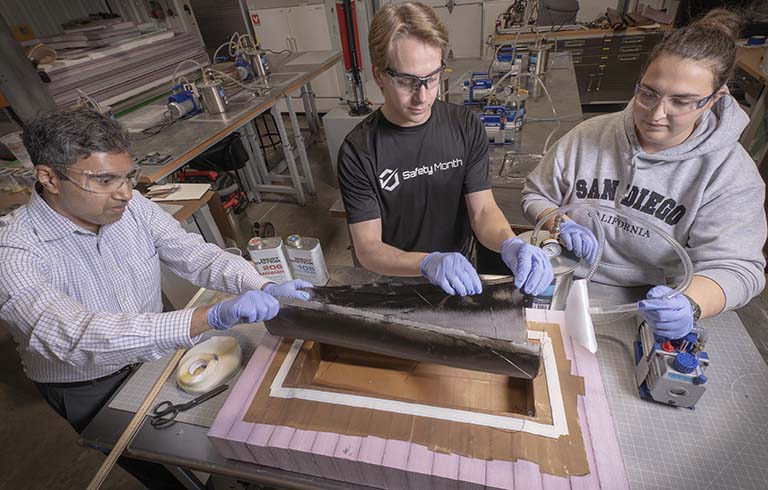
From the ground into the air: Trine students working with advanced resins
Trine University has received a grant from the Indiana Space Grant Consortium (INSGC) to support students conducting advanced aerospace composite research.
October 26, 2023
It wasn’t a first-time experience when Trine University biomedical engineering senior Amy Apgar presented her research at the Biomedical Engineering Society (BMES) annual meeting this October.
However, the trip to Seattle, Washington, did provide the student from Wickliffe, Ohio, the opportunity to see her first mountain.
Apgar’s poster presentation, entitled “Probiotics Formulation and Delivery Using Nanocultures,” represented the culmination of her work during a summer Research Experience for Undergraduates (REU) at the University of Pittsburgh.
Apgar worked with a research group that focuses on probiotic formulation and delivery using microscopic biodegradable polymer capsules containing healthy bacteria.
The long-term goal for the research is to create a library of probiotic capsules that can be used as personalized therapeutics for treating diseases such as C. difficile infection. C. difficile is drug-resistant bacterial infection in the colon that can lead to death in older patients.
Her project focused on creating a library of E. coli Nissle microcapsules with the use of a high-resolution fluorescent microscope. This library can be used in the future design of oral delivery methods for additional healthy bacteria strains.
“As a biomedical engineer, I get limited exposure to culturing bacteria, but I have always been interested in working with it more often. I also found it exciting to make and use my own microfluidic devices,” said Apgar.
Apgar was the only BME student working in a chemical engineering lab. She was able to bring her course experiences in anatomy, physiology, microbiology, biofluids and biomaterials to add a new layer of expertise to the team.
The success of the project provided an opportunity for Apgar to present her work at the BMES conference. In addition to the presentation, she took full advantage of the networking and learning opportunities available to her.
“I was able to meet with a bunch of graduate schools and professors I'm interested in working with, take some professional headshots, and receive resume critiques,” she said.
Outside of the conference, Apgar also got to experience the city of Seattle.
“I saw the space needle, visited the Chihuly Garden and Glass museum, walked through Pike Place market, and of course Starbucks. I also saw my first mountain!” she noted.
Apgar is excited to bring back information from both the conference and REU to support her Indiana National Space Grant Consortium (INSGC) research here on campus.
She plans to incorporate some of the skills she learned into studying the relationship between the microbes of the skin and the lymphatic system, further studying how these relationships are impacted by microgravity and insufficient oxygen.
“At the conference, I was able to see some similar research on organ-on-a-chip systems that could be used to help with the space grant. I think that connections I made at this conference could serve as references for further research and potentially senior design,” she said.
This experience represented both the second REU and BMES presentation for Apgar, who spent the previous summer as a researcher within the Chemical and Biological Engineering department at Iowa State University.
Over the past two years, Trine’s Bock Department of Biomedical Engineering has placed 16 students in summer research experiences. Currently, 25% of BME students move on to graduate research programs following graduation.
“REUs are exceptional opportunities for students to extend their knowledge gained at Trine in order to grow professionally and personally,” said Maria Gerschutz, Ph.D., department chair. “The programs are excellent platforms for preparing students for graduate school or research-oriented careers. Our students return to campus with increased confidence in their research abilities and excitement toward potential research career paths ahead.”
Apgar’s summer REU advisor recently moved to Carnegie Mellon University. She hopes to follow the group and pursue a Ph.D. in biomedical engineering at CMU next fall, continuing her research into the microorganisms that live in the digestive tract.